Well, we basically have the best of summer in one recipe right here. Sweet Corn Basil Ravioli is it. Plan for it to be on repeat for oh – now until the unspeakable happens.

It’s hard to talk about this time of year because while, yes, there’s nothing more I love talking about than fresh summer produce, it means the end is right around the corner. Soon enough the leaves will fall, and then the snow will too. This is the best of the end-of-summer produce after all.
But the glass is half full! Because what fun would it be if it wasn’t?
Let’s talk about the fresh sweet corn, that here in the Midwest, is like no other.
The juicy tomatoes that have been growing all summer long are now plump and ready to be savored. The fresh basil is overgrowing and looking for a home that’s something other than pesto (because let’s be honest, you already have so much of it in your fridge).
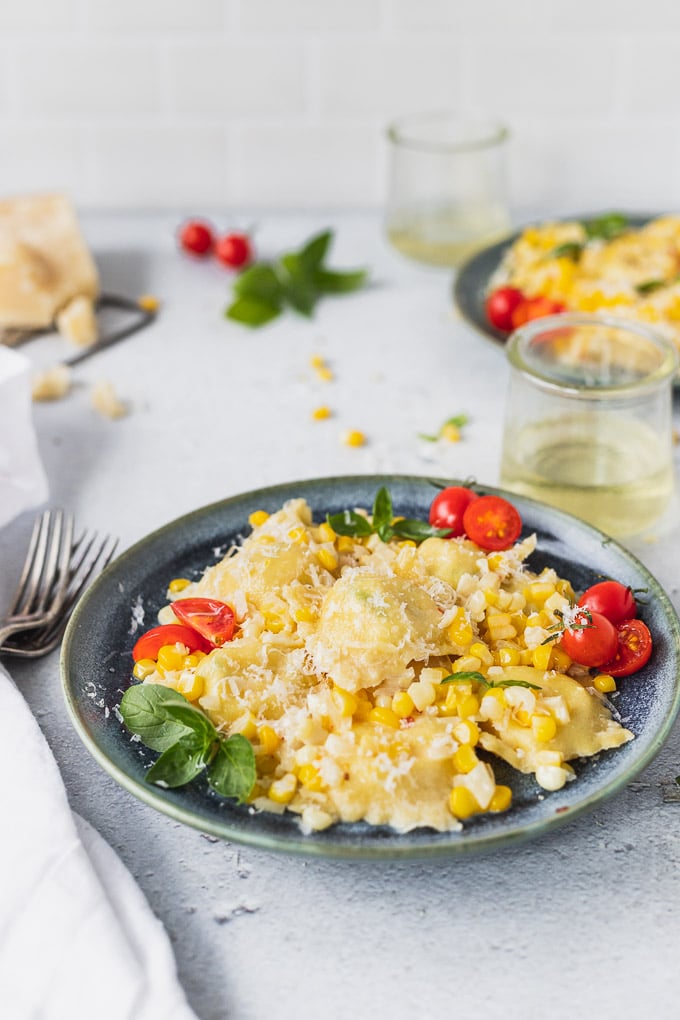
Yes, my lovely friends, those are our star players here and they have brought their A-game.
Not to mention we have homemade ravioli! Nothing like Midwest sweet corn at the end of August, and nothing like homemade pasta.
Now, before you might run off because you’re intimidated by homemade pasta, WAIT. It’s not hard. And I promise you, once you learn, you’ll wonder what took you so long. Let’s check it out.
HOW TO MAKE HOMEMADE PASTA
We’ve talked about it before – here in this post – so I’ll briefly give you an overview here. Be sure to also check Homemade Cheese Ravioli when those pesky cold months show up.
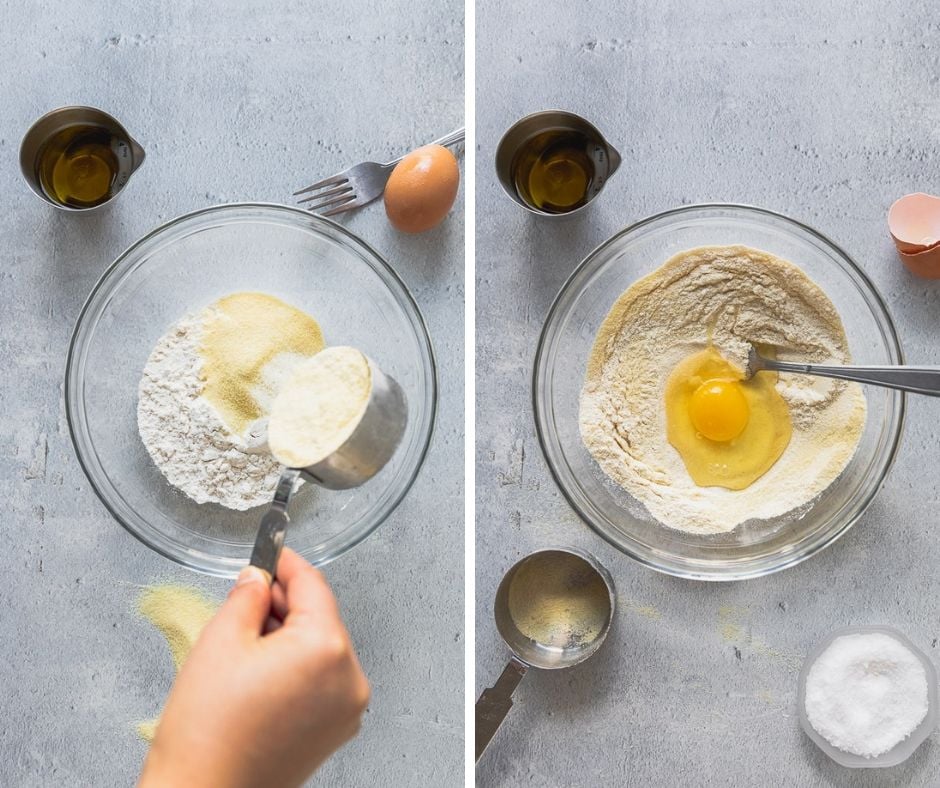
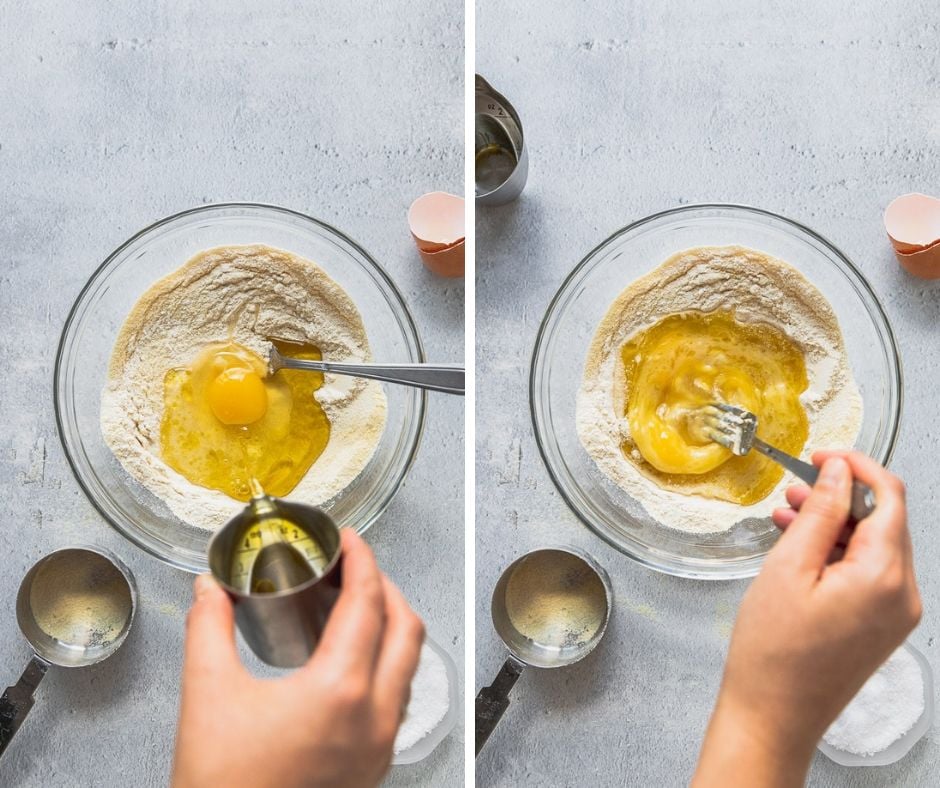
But now, let’s get to the low-down of homemade pasta.
- Semolina* and all-purpose flour is my favorite combination. For many years I’d just all semolina, which totally works if you prefer. It creates a more dense pasta, IMO. And all-purpose flour is a lot easier for me to find than any finer ground pasta flours. So AP it is.
- Take a fork and begin to mix in an egg, olive oil, and water.
- Use those (clean) hands to finish mixing it up and knead the dough. The key is to get it to the point of tacky, but not sticky.
- Let it rest.
- Roll it out*.
- Fill your pockets of ravioli.
- Bada bing, bada boom, boil them up and enjoy!
Ok, so, how do I roll out ravioli?
If you check out my how to make ravioli post, you’ll see I use more of a “long sheet and fold it over technique”.
I think I’m forever changed since using a ravioli mold for this sweet corn ravioli recipe! It had a couple of minute learning curve, but once I figured it out, it made the CUTEST little ravioli – that absolutely rivaled the appearance of my homemade ones. Rustic is sometimes cute.
The pasta maker* I have (er, took from my parents. Thanks, mom and dad! ;)) came with a plastic form and with a metal cut-out piece. If you’re also confused by the two pieces, let me try to explain.
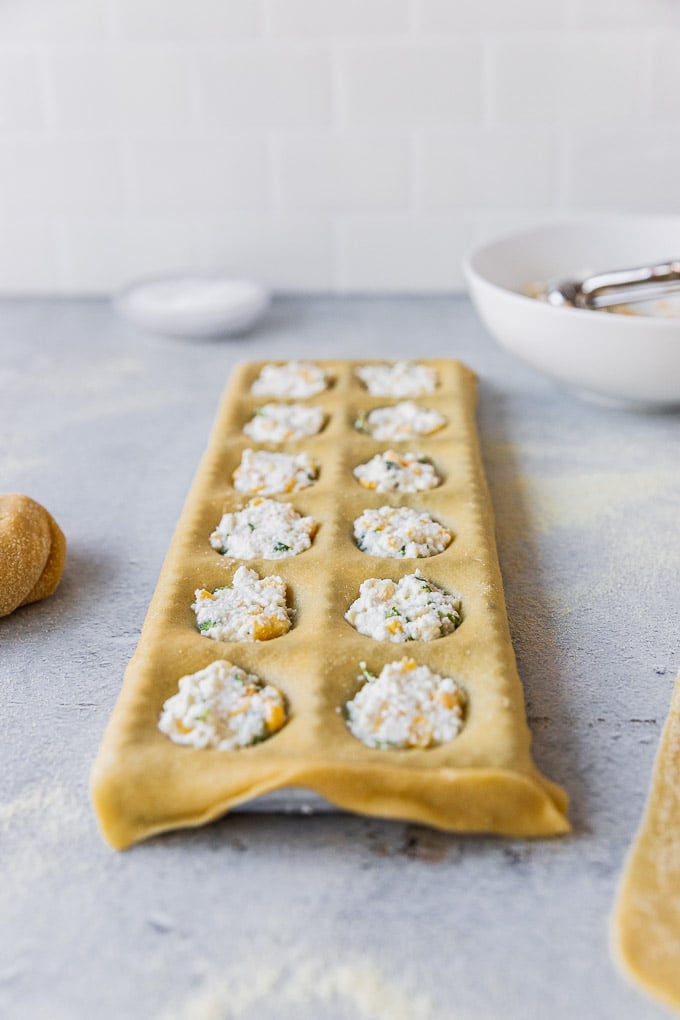
- Sprinkle semolina flour along the cutting edges the metal cut-out sheet and then place a sheet of pasta over it, making sure the dough falls over the sides somewhat.
- Place the plastic form (with the divets) on top of the pasta sheet, pressing down gently to stretch the dough, creating the little nests for the ricotta ravioli filling.
- Remove the plastic piece and fill the “pasta nests” with about 2 teaspoons of filling (depending on your molds).
- Lightly rub water along the edges of what will be the pasta. This helps the pasta stick together – just don’t add too much or it will get gummy.
- Take a second sheet of pasta dough and place it on top of the filled ravioli sheet.
- Using a rolling pin, roll it over and the metal piece will “cut out” the ravioli.
- Flip over the mold and out will pop your ravioli (you may need to gently coax them depending on how well you dusted it with semolina).
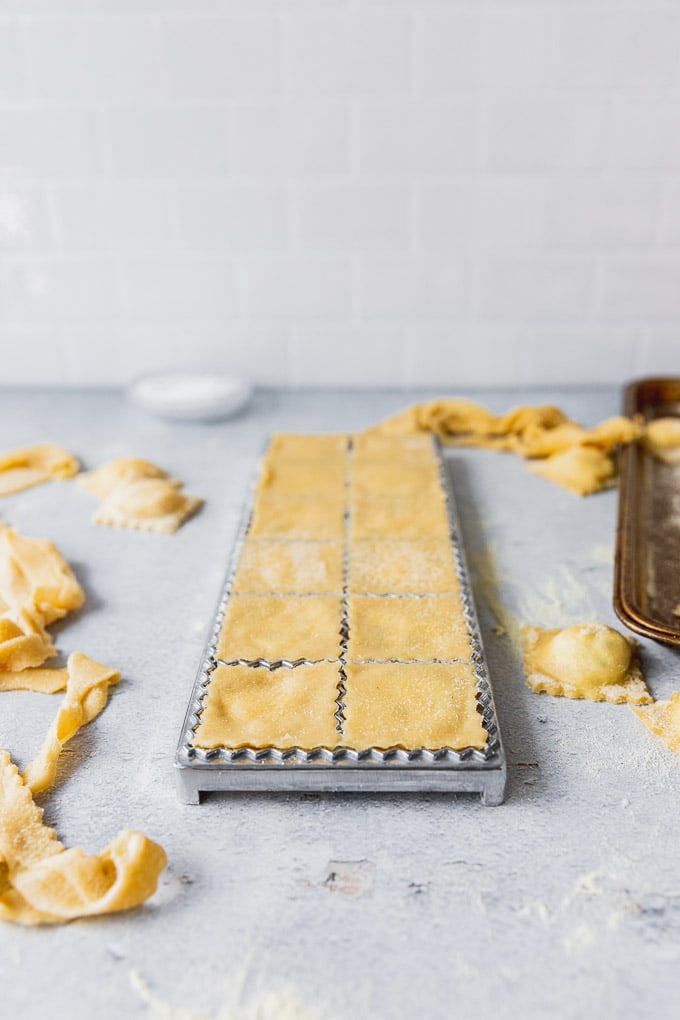
And then like I said, bada-bing, bada-boom. And don’t forget you don’t need a mold. Really! It’s super easy to just roll out the sheets and make them yourself.
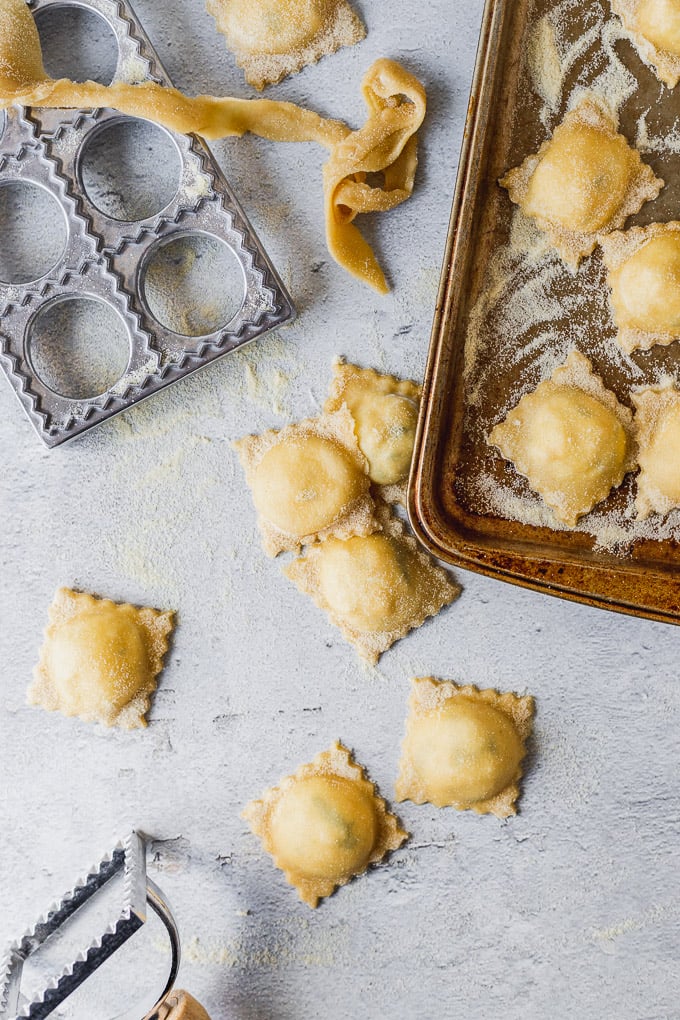
THE FILLING
Naturally, I don’t think many ravioli fillings should be without ricotta. Especially living this flexitarian life, ricotta ravioli is my ultimate go-to.
But friends, Sweet Corn Basil Ravioli takes ricotta to an entirely new ravioli level. The filling has – wait, can you guess? – ricotta. 🙂
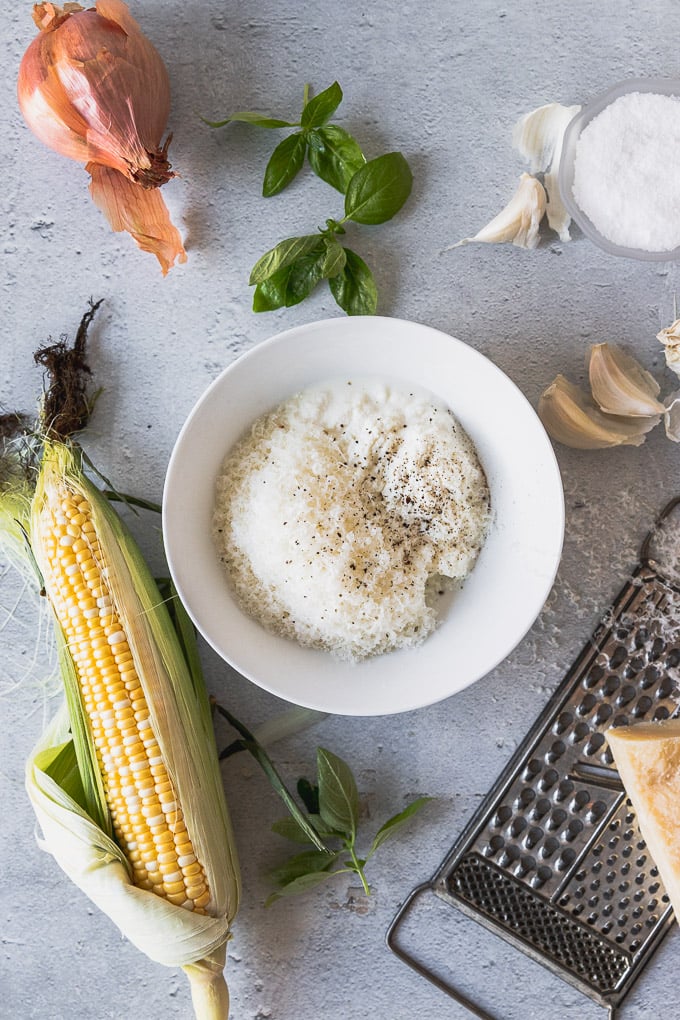
It also has FRESH sweet corn, roughly chopped so you still get the texture. We’ve also got lots of fresh basil in there (I did mention summer produce!), and some parmesan for extra cheese and saltiness.
It’s creamy and fresh, and slightly salty, and those pillows of ricotta all snuggled between the layers of fresh pasta is basically life-changing.
THE SAUCE
So many people worry about what sauce to use with ravioli. And here I’m going to give you my go-to for this sweet corn ravioli, because it has, butter and corn as every summer dinner should. But do remember that a little imagination and fresh produce goes a long way.
The sauce for this ravioli recipe is really easy (win!). It’s luxuriously butter, but not overpowering so. It’s also light and fresh, and just enough creamy.
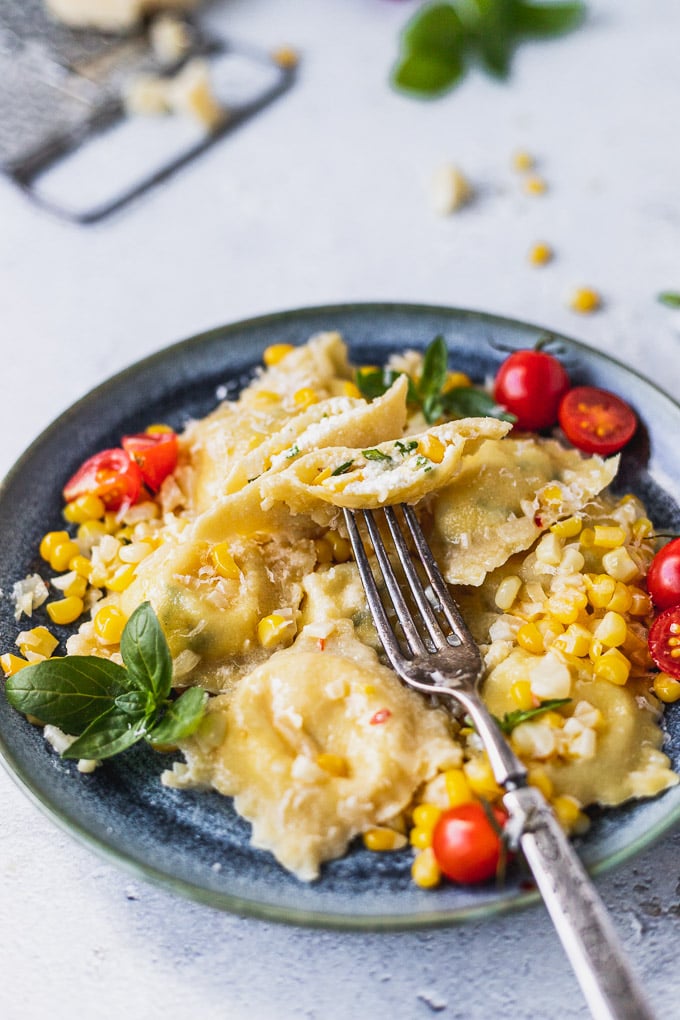
The butter melts, the corn cooks – with a bit of salt and red pepper flakes for depth of flavor – then the wine goes in to deglaze the pan (you can use vegetable stock if you don’t have or want wine). Add some pasta water to loosen it up and help the sauce stick to the ravioli. Then top with fresh basil and some garden fresh tomatoes for extra brightness, and you’re set!
Speaking of, the tomatoes do add a bright acidity to the pasta. While you could leave them out (and they’re not technically cooked in the sauce because they felt lighter when served fresh), I definitely think they add a layer of texture and flavor to the pasta.
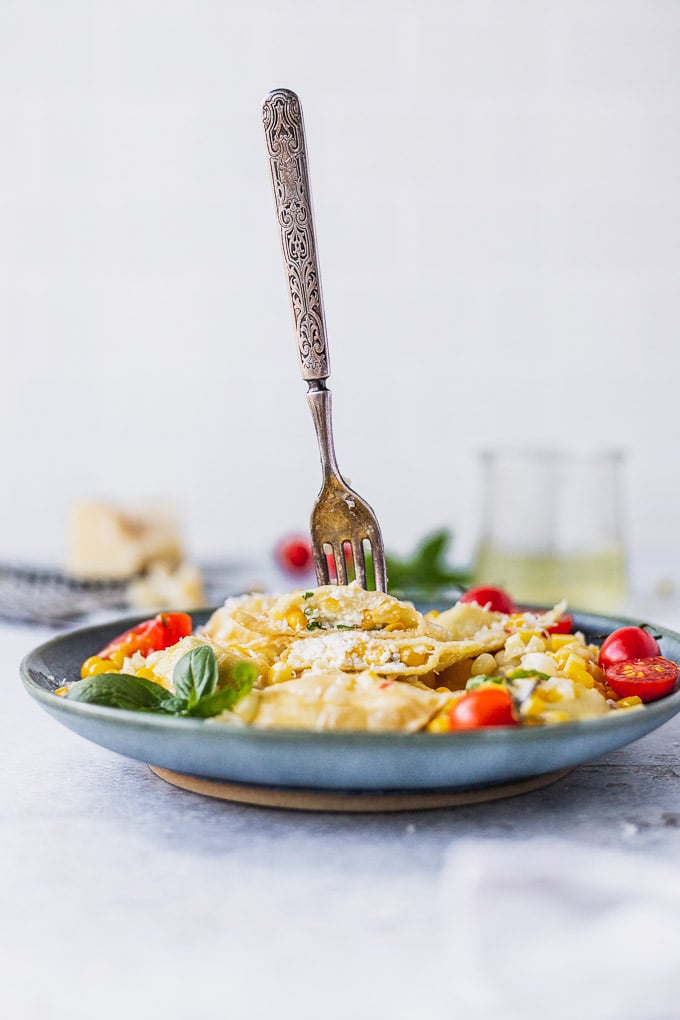
Enough now! You’ve got it down how to make homemade pasta, how to use a ravioli mold if you need to, and how to make everything about this sweet corn ravioli, so get to it!
More Ravioli Recipes

Get the Recipe Homemade Sweet Corn Basil Ravioli
Ingredients
PASTA:
- 1/2 cup semolina flour*
- 1/2 cup all-purpose flour
- 1 teaspoon fine sea salt
- ⅛ teaspoon fine freshly ground black pepper, optional
- 1 egg
- 2 Tablespoons water
- 1 teaspoon olive oil
FILLING:
- 3/4 cup whole milk ricotta cheese
- 1 corn on the cob, kernels roughly chopped
- 1 garlic clove, minced
- 1 1/2 Tablespoon fresh basil, chopped
- 1/4 tsp fine sea salt
- 1/3 cup freshly shredded parmesan cheese
SAUCE:
- 3 Tablespoon butter, high quality butter is best
- 1 shallot, finely diced
- 2-3 garlic cloves, minced
- Dash of red pepper flakes, to taste
- Salt, to taste
- 1/4 cup white wine
- 1 corn on the cob, kernels cut off
- 2 Tablespoon heavy cream
- 1/4 cup reserved pasta water
- 1/2 cup cherry tomoatoes, quartered
- Basil, for garnish
Instructions
- PASTA: In a bowl, stir together the flours, salt, and pepper. Make a well in the middle of the flour, and add the egg (you can whisk it before adding it into the well), as well as the water and olive oil. Take a fork and gently run it around the flour where it meets the wet ingredients. You’ll gently incorporate all the flour into the wet ingredients. When mostly combined, I recommend using your hands to mix until a ball forms. Then continue kneading for 3-4 minutes until tacky, but no dough should stick to your hands. Adjust adding a bit of flour or water if needed. The dough will slowly break apart when pulled, instead of immediately tearing apart. Place in a reusuable baggie or cover in a bowl and let rest for at least 30 minutes.
- Ravioli Filling: meanwhile, mix the filling by stirring together all the filling ingredients (ricotta, 1 ear of roughly chopped corn kernels, garlic, basil, salt, and parmesan). Set aside.
- Roll out the pasta dough: depending on your method of making the ravioli (mold or no mold), you will still want to have 4 rectangular sheets of pasta in the end. Divide the dough into 4 equal pieces. I start with a piece molded into about 4 inches by 1 1/2 inches before putting it into my pasta roller*. Beginning on the largest setting and continuing to roll the pasta dough sheet through each setting until it’s at the second to thinnest setting. Continue rolling out each piece of dough, letting the sheets rest on a dusting of semolina flour. Place on top of ravioli mold or lay on a thin dusting of semolina flour. Place the filling inside the pasta mold* (if doing this by hand put the filling on one side of the dough sheet and fold it over). Brush the edges lightly with water, and layer the other pasta sheet on top of the mold; roll over it with a rolling pin to seal and cut the edges of the ravioli. Place cut ravioli on a baking sheet sprinkled with semolina flour.
- Bring a large pot of salted water to a boil (add the leftover corn cobs to flavor the water and reduce waste – remove them before adding the ravioli!).
- As the water comes to a boil, prepare the sauce by heating a large skillet over medium-high heat. Add butter and once bubbling slightly add the chopped shallot. Stir and let cook for 1-2 minutes; add the garlic and let cook for another 1-2 minutes. Make sure you layer in some salt throughout, but be sure to add it at this point. Add the wine to deglaze the pan and let simmer down for about 2-3 minutes. Stir in the corn kernels and let cook for 1-2 minutes. Add the reserved pasta water (by this time you will have boiled some ravioli, see next step) and let the sauce boil to thicken slightly. Stir in the heavy cream before finishing.
- Once you add the corn to the sauce, you should begin boiling some of the ravioli. Don’t overcrowd the pan; depending on your pot size, you usually need to do about 2 batches. Let the first round of pasta cook for about 1 – 1 1/2 minutes and transfer to the sauce, where it will continue cooking, It’s here that you can take some reserved pasta water. Boil the next batch of ravioli, this time a little bit longer, because they won’t sit in the sauce as long (or, just keep them in the sauce longer :)).
- Remove ravioli and top with the fresh tomatoes, and extra parmesan as you wish. Serve with fresh basil and enjoy!
Notes
- *Look for cheese specifically labeled vegetarian, if needed.
*This post contains Amazon Affiliate Links. Thanks for your continued support to keep FITK running!






This is so delicious and bursts with the flavors of summer! The sauce is the perfect balance of light and rich and the fresh corn, tomatoes and basil really make the pasta sing! For a weeknight cheat, I use refrigerated ravioli from the grocery store, but homemade is the very best!
I’m so glad you enjoyed the sauce, Molly! Love the quick weeknight hack, too!
Looks amazing! Do you have to steam or cook the corn before it goes in the filling? Or will cooking the pasta cook the corn?
Thanks, Jason! You don’t have to cook the corn that goes in the filling of the ravioli; because it’s chopped up it cooks enough when the ravioli cooks. Hope that helps, I’d love to hear how it turns out!
I originally chose this pin because the sauce looks delicious but decided to use the ravioli recipe for a red sauce today. Anyway, huge flop!! With course salt and freshly cracked pepper in the dough mix, it created holes in each strip I ran through my machine. And unfortunately I doubled the batch. Needless to say it all went in the garbage. I honestly don’t know how it could work with those 2 items. I wish I had used common sense and left those out. But I am anxious to try the sauce recipe.
Hey Erin – so sorry to hear you had trouble with the homemade pasta. I’m curious what kind of salt (and brand) you did end up using; if you used coarse sea salt that needs to be ground (without grinding it), yes, that would be much too large. However, if you’re using coarsely ground sea salt that is similar in texture to kosher salt, something else might have been happening to create holes in the dough. When the dough doesn’t roll smoothly, tears, and has holes as you describe, it can be that the dough is in fact too dry, hasn’t been kneaded enough for the gluten to form, or if it hasn’t been folded flat enough to roll through properly. With a little more kneading, adjusting moisture levels, or pressing the dough flat, the problem should be fixed.
Considering the salt, if you don’t want to go the kosher salt route, halve the amount of salt and use regular table salt or fine sea salt if you give the pasta a try next time and omit the black pepper as it is optional. Hope you enjoy the sauce!